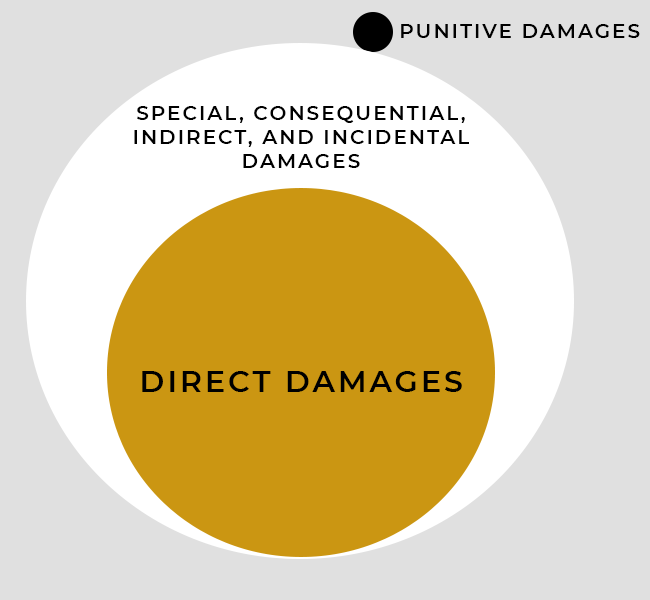Understanding Basic Contracts: Liability Limitations
February 24, 2022 | By Candace Groth
We are back with our Understanding Basic Contracts series with a post about the often seen, but little understood, “Liability” or “Liability Limitation” Section.
The liability limitation section, much like the indemnification clause, is all about allocating risk and monetary exposure between the two parties to an agreement. Generally, one party to a contract is providing goods or services and the other party is receiving those goods and services. Inherent in that relationship are risks, including the product/service being defective, a party not paying for the products/services, employees/personnel of either party being injured during the performance of the agreement, and a third party being injured by the product or service in some capacity.
Indemnification is all about each party taking responsibility for certain risks related to the contract. The liability limitation section is an acknowledgment that each party should only take on a certain amount of monetary liability and liability for types of damages that could occur arising out of or related to the agreement. We will discuss the two types of liability limitations in turn.
Types of Damages Liability Limitation
The first type of liability limitation is the damages liability limitation. Case law and state/federal laws break down the types of losses or damages a party might suffer related to a legal claim into three broad categories.[1] These are described below:
Direct Damages (Compensatory Damages)
Direct or compensatory damages are intended to compensate a party for the direct results of a claim. For example, if the claim is for a breach of the contract, specifically non-payment of fees, direct or compensatory damages would attempt to place Party A (who didn’t breach the contract) in the same position it would have been in without Party B (who breached the agreement by not paying the fees). In other words, Party A receives the profit (revenue less expenses) that it would have received for the contract if Party A fully performed and if Party B paid in full. Direct damages may include payments for unpaid fees under an agreement, medical expenses (if a party is injured), monetary payments to replace damaged property, or similar direct results of a legal claim.
Special, Consequential, Indirect, and Incidental Damages
Unlike direct or compensatory damages, special damages, which are also called consequential and/or incidental damages, relate to the indirect results of a claim for damages. For example, in a breach of contract claim, as described above, direct damages would be the profit that Party A would receive if the contract was fully performed. Consequential damages, in contrast, include damages/losses that flow from the breach of contract, but are more tangential. For example, if the claim is for battery, namely Party B attacked Party A with a baseball bat and caused injuries, consequential damages might include Party A’s salary, since Party A was unable to work his scheduled shifts at Pizza Hut as a result of the battery.
 Consequential, incidental, special, and indirect damages may include damages for property damage, lost wages/profits, etc… You can think about direct damages versus other types of damages as a set of gradually expanding circles, with direct damages at the center, closely related to the type of claim, with the other types of damages farther out and therefore less related to the claim. Eventually, at the outskirts of the circles, you come to damages that a party might try to claim are related to a claim (because something bad happened) but are so far removed that they are not recoverable.
Consequential, incidental, special, and indirect damages may include damages for property damage, lost wages/profits, etc… You can think about direct damages versus other types of damages as a set of gradually expanding circles, with direct damages at the center, closely related to the type of claim, with the other types of damages farther out and therefore less related to the claim. Eventually, at the outskirts of the circles, you come to damages that a party might try to claim are related to a claim (because something bad happened) but are so far removed that they are not recoverable.
Punitive or Exemplary Damages
Finally, we come to punitive or exemplary damages. This damages category, only available in most states for certain types of claims, is a type of damages meant to deter or “punish” a party, generally for intentional bad behavior. For example, punitive damages might be requested if Party B intentionally and maliciously said false things (libel) about Party A so that Party A’s business would be harmed and go bankrupt. Again, punitive or exemplary damages are not allowed for all types of claims and are less common than direct or other types of damages.
A typical “types of damages” clause attempts to limit a party’s liability for damages to only “direct damages” and to exclude other types of damages that are more tangential, such as consequential damages. Usually, the type of damages limitation will apply to all claims, but on occasion a party will ask that certain claims (such as Confidentiality) be excluded. The type of damages limitation clause may apply to one or both parties, although a mutual clause tends to be the most common in non-boilerplate agreements.
Monetary Liability Limitation
The second type of liability limitation is the monetary liability limitation. This limitation generally takes two different forms. One is a maximum cap on the amount of monetary damages a party (or both parties) are responsible for related to a particular type of claim or section under the agreement. For example, the contract may state the following:
In no event will Party A’s liability for claims arising out of or related to Section 10, Confidentiality of this Agreement exceed $500,000.00
The other type of monetary liability limitation is a general maximum cap on the amount of monetary damages for a party (or both parties). For example:
In no event will either Party’s liability for claims, damages, or losses, arising out of or related to this contract exceed twelve (12) months of fees actually paid by Party B under the contract.
It is common for the parties to link the total monetary exposure of a party to the amount paid under the agreement in some manner (e.g., 6 months of fees). You may also see the amount of insurance carried by a party for a type of claim used, particularly for contracts related to cyber security or healthcare, although this carries risks including a lapse in coverage, multiple parties being involved in a single claim, etc…
Liability limitation language, as described above, can be confusing and difficult to read, but it is critical to understand, so it is important to not try to navigate these clauses on your own. Loop in your attorney to create (or negotiate) a liability limitation clause that fits your industry, business, and risk appetite.
[1] Each state’s law classifies certain types of damages a little differently. This blog describes the types of damages generally, but you should consult with local counsel for specifics in your jurisdiction.

